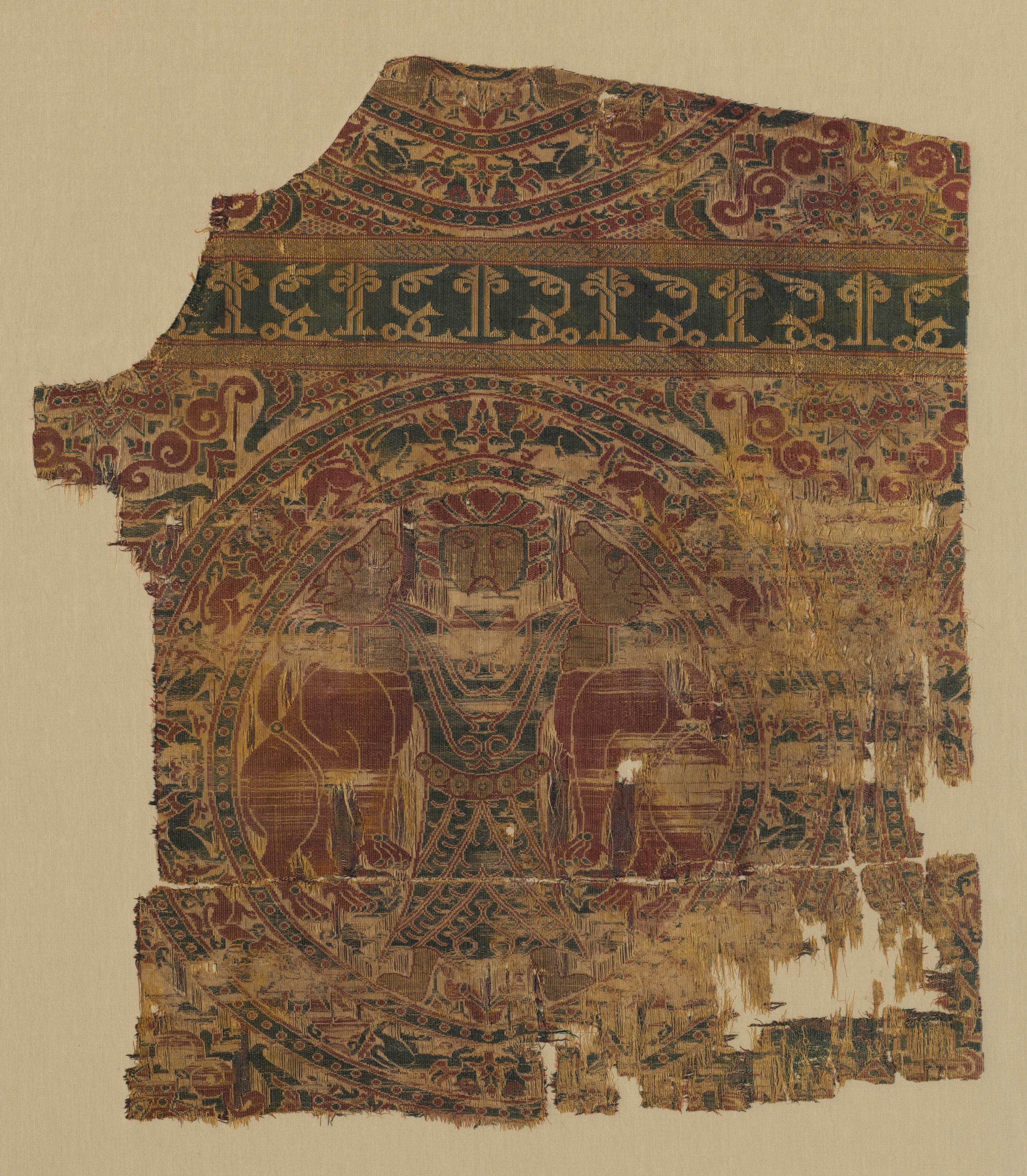The Cleveland Museum of Art
Collection Online as of May 5, 2024

Fragment with Lion Strangler from a Dalmatic of Saint Bernard Calvo
1200–1243
Overall: 43.8 x 39.7 cm (17 1/4 x 15 5/8 in.); Mounted: 53 x 49.8 cm (20 7/8 x 19 5/8 in.)
Purchase from the J. H. Wade Fund 1950.146
Location: not on view
Description
Within the elaborate roundel, a bearded man with a belted tunic strangles a lion in each hand. Gold thread shimmers on their heads and his hands. In the inscription band across the top, an Arabic word has been written with mirror-image symmetry. It can be read as al-yumn, primarily translated as prosperity.The central motif of this renowned silk is a pre- Islamic Persian symbol of royal power. Both Muslims and Christians throughout the Iberian Peninsula admired such textiles. Members of the Catholic clergy incorporated it into a dalmatic—a long ceremonial tunic. It was found in the late 1800s in the tomb of Saint Bernard Calvo, Bishop of Vich (1180–1243).
- from tomb of St. Bernard Calvo, Bishop of Vich, who died in 1243; this fragment from one of vestments found in tomb at the Cathedral of Vich when it was opened at the end of the 19th century?-1950(Paul O. Berliz, New York, NY, sold to the Cleveland Museum of Art)1950-The Cleveland Museum of Art, Cleveland, OH
- Shepherd, Dorothy G. "A Twelfth-Century Hispano-Islamic Silk." The Bulletin of the Cleveland Museum of Art 38, no. 3 (1951): 59-62. p. 59-62 25141697.Shepherd, Dorothy G. "A Dated Hispano-Islamic Silk." Ars Orientalis 2 (1957): 373-82. p. 373-82 4629043.The Cleveland Museum of Art. The Cleveland Museum of Art Handbook. Cleveland, OH: The Cleveland Museum of Art, 1958. Mentioned and Reproduced: cat. no. 119 archive.orgThe Cleveland Museum of Art. Handbook of the Cleveland Museum of Art/1966. Cleveland, OH: The Cleveland Museum of Art, 1966. Reproduced: p. 218 archive.orgThe Cleveland Museum of Art. Handbook of the Cleveland Museum of Art/1969. Cleveland, OH: The Cleveland Museum of Art, 1969. Reproduced: p. 218 archive.orgThe Cleveland Museum of Art. Handbook of the Cleveland Museum of Art/1978. Cleveland, OH: The Cleveland Museum of Art, 1978. Reproduced: p. 275 archive.orgBrett, Michael, and Werner Forman. The Moors: Islam in the West. London: Orbis Pub, 1980. p. 21Ettinghausen, Richard, Oleg Grabar, and Sheila Blair. The art and architecture of Islam, 650-1250. Harmondsworth, Middlesex, England; New York: Penguin Books, 1987. p. 161, fig. 140Mackie, Louise W. Symbols of Power: Luxury Textiles from Islamic Lands, 7th-21st Century. Cleveland; New Haven: Cleveland Museum of Art; Yale University Press, 2015. Reproduced: P 175, fig. 5.6; Mentioned: P. 174, 177Akin, Esra. Muthanna / History, Theory, and Aesthetics. Bloomington, IN: Indiana University Press, 2020. Mentioned and Reproduced: p. 139, fig. 5.9
- Al-Andalus: Art from Islamic Spain (Islamic art rotation). The Cleveland Museum of Art, Cleveland, OH (organizer) (October 29, 2019-October 25, 2020).Islamic art rotation. The Cleveland Museum of Art, Cleveland, OH (organizer) (December 16, 2013-December 15, 2014).Islamic Gallery 207 Rotation. The Cleveland Museum of Art, Cleveland, OH (organizer) (June 19, 2001-June 3, 2002).Gallery 207 textile rotation. The Cleveland Museum of Art, Cleveland, OH (June 19, 2001-June 3, 2002).35th Anniversary Exhibition. The Cleveland Museum of Art, Cleveland, OH (organizer) (June 20-September 30, 1951).
- {{cite web|title=Fragment with Lion Strangler from a Dalmatic of Saint Bernard Calvo|url=false|author=|year=1200–1243|access-date=05 May 2024|publisher=Cleveland Museum of Art}}
Source URL:
https://www.clevelandart.org/art/1950.146